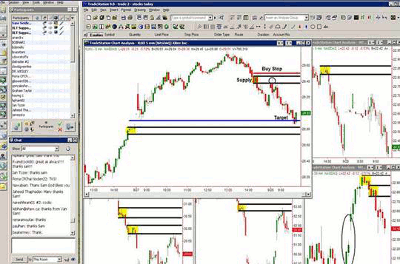Gaps represent big supply/demand imbalances and are a favorite set-up for more experienced traders in particular. Here are four rules for better understanding gaps and exploiting their high profit potential.
Novice gaps are the ultimate picture of novice greed in the market. Why do I make gaps such an important part of our education program? Simple, because gaps are the most obvious way to spot a novice market speculator.
Remember, if you can't spot the novice, consistently losing trader in a market, the novice trader is probably you. Just like with a game of poker, if you sit down at the table and can't figure out quickly who will pay the table that night, it is likely going to be you.
Gaps in price are great because they are the picture of a strong supply and demand imbalance when you understand them. Not every gap sends the same message or represents the same opportunity, so we structure them into an understandable checklist.
Once this is done, we can use this information to spot the picture of very novice buying or selling and be there to take the low-risk, high-reward, and high-probability trades.
Below is a chart of Xilinx, Inc. (XLNX):
In a class I was teaching one morning, before the market opened and fell, we were going over the stock market. (We do our analysis when the market is not open and moving so we can be very objective and plan our trades in advance to take care of the emotional issues related to trading for new traders.)
That morning, there was a gap up in the market after a rally in price, in the context of a downtrend, and into an area of supply (resistance).
This is a clear novice trader signal because it represents such a huge mistake. Anyone who buys after a period of buying, and at price levels where supply exceeds demand, and in a market whose average price is declining, is going to lose consistently over time; the laws of supply and demand ensure that. They may have a winning trade once in a while, but over time, they will lose the majority of the time.
The only action worse than those two mistakes is when that person is buying a gap up, and that is what we had above with our XLNX opportunity.
NEXT: 4 Key Factors for Trading Gaps
|pagebreak|What we did next was to look at where the demand was below and determined it was much lower (blue line). This set up a scenario that suggested the path of least resistance is down, and once the market opened right into our supply level where we planned to sell short, price proceeded to decline to demand, our profit target.
Could we have been wrong? Of course; that's trading, which is why we focus so much on risk.
Our goal in trading is not to create certainty, because that never exists. Our goal is to become masters at objectively assessing the odds, which means objectively quantifying real supply and demand, and that is what we did.
See related: It All Starts with Supply and Demand
Let's get back to gaps. In our classes, we keep it simple. Here are four rules to keep in mind when you have a gap:
- A gap up in price, into supply, after a rally in price, and in the context of a downtrend, is a very high-probability shorting opportunity
- A gap up in price, and in the context of an uptrend, is a lower-probability shorting opportunity and can actually be a buying opportunity on a pullback to demand when there is a significant profit margin above
- A gap down in price, into demand, after a decline in price, and in the context of an uptrend, is a very high-probability buying opportunity
- A gap down in price, and in the context of a downtrend, is a lower-probability buying opportunity and may in some cases be a shorting opportunity after a rally into supply when there is a significant profit margin below
See related: Best (and Worst) Gap Trading Set-Ups
While there is much more on gaps than I can write about, in a short piece such as this one, keep in mind that the picture of the ultimate supply and demand imbalance is a gap.
When you are ready to take a trade, simply ask yourself, "Who is on the other side of my trade?" and make sure you are trading with someone who is making a big mistake according to the laws of supply and demand, motion into mass, or whatever version of this basic governing dynamic you want to call it.
Instead of looking at red and green candles on a chart and following a conventional technical analysis book, start looking a little deeper and begin to understand the order flow that's going on behind the scenes that is responsible for the creation of those candles.
These basic thoughts will likely give you an edge over those who are on the other side of your trades, and having that edge is the key to trading anything.
See related: All Great Traders Have an Edge-Do You?
If you are tired of transferring your account into someone else's, stop looking at the market the same way everyone else does!
By Sam Seiden, instructor, Online Trading Academy












